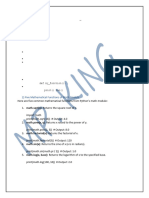UNit 2 python
Uploaded by
robrayl02UNit 2 python
Uploaded by
robrayl02Here are detailed answers to your questions:
1. Boolean Function with Examples
A Boolean function is a function that returns a Boolean value (True or False). These
functions are commonly used in decision-making processes in programming.
Example 1: Checking Even or Odd
def is_even(num):
return num % 2 == 0 # Returns True if number is even, False otherwise
print(is_even(4)) # Output: True
print(is_even(7)) # Output: False
Example 2: Checking If a Number is Prime
def is_prime(n):
if n < 2:
return False
for i in range(2, int(n**0.5) + 1):
if n % i == 0:
return False
return True
print(is_prime(11)) # Output: True
print(is_prime(10)) # Output: False
2. Void Function with Examples
A Void function is a function that does not return a value (returns None by default). It is
often used to perform an action rather than compute and return a result.
Example 1: Printing a Message
def greet():
print("Hello, welcome to Python!")
greet() # Output: Hello, welcome to Python!
Example 2: Displaying a List
def display_list(items):
for item in items:
print(item)
fruits = ["Apple", "Banana", "Cherry"]
display_list(fruits)
# Output:
# Apple
# Banana
# Cherry
3. Various String Operations in Python
Python provides various string operations, including:
1. String Concatenation
s1 = "Hello"
s2 = "World"
result = s1 + " " + s2
print(result) # Output: Hello World
2. String Slicing
s = "Python"
print(s[0:4]) # Output: Pyth
print(s[-1]) # Output: n
3. Converting Case
text = "Hello World"
print(text.lower()) # Output: hello world
print(text.upper()) # Output: HELLO WORLD
print(text.title()) # Output: Hello World
4. Checking Substring
s = "Python Programming"
print("Python" in s) # Output: True
print("Java" in s) # Output: False
5. String Splitting and Joining
s = "apple,banana,grape"
words = s.split(",") # Splits based on ","
print(words) # Output: ['apple', 'banana', 'grape']
joined = "-".join(words)
print(joined) # Output: apple-banana-grape
6. Finding and Replacing a Substring
s = "I love Python"
print(s.find("Python")) # Output: 7 (index where "Python" starts)
print(s.replace("Python", "Java")) # Output: I love Java
4. Math Module
The math module in Python provides various mathematical functions.
1. Importing the Math Module
import math
2. Common Functions in math Module
Function Description Example
math.sqrt(x) Square root of x math.sqrt(25) → 5.0
math.factorial(x) Factorial of x math.factorial(5) → 120
math.pow(x, y) x raised to power y math.pow(2, 3) → 8.0
math.ceil(x) Rounds up x math.ceil(3.2) → 4
math.floor(x) Rounds down x math.floor(3.8) → 3
math.pi Value of π math.pi → 3.141592653589793
math.sin(x) Sine of x (in radians) math.sin(math.pi/2) → 1.0
Example: Using math Functions
import math
print(math.sqrt(16)) # Output: 4.0
print(math.factorial(5)) # Output: 120
print(math.ceil(2.3)) # Output: 3
print(math.floor(4.8)) # Output: 4
5. Python Programs
(a) Fibonacci Series
def fibonacci(n):
a, b = 0, 1
for _ in range(n):
print(a, end=" ")
a, b = b, a + b
fibonacci(10) # Output: 0 1 1 2 3 5 8 13 21 34
(b) Factorial Using Recursion
def factorial(n):
if n == 0 or n == 1:
return 1
return n * factorial(n - 1)
print(factorial(5)) # Output: 120
(c) Check Whether a String is Palindrome
def is_palindrome(s):
return s == s[::-1]
print(is_palindrome("madam")) # Output: True
print(is_palindrome("hello")) # Output: False
(d) Find the Square of a Number Using Functions
def square(n):
return n * n
print(square(5)) # Output: 25
You might also like
- Value Proposition: HP Indigo 7500 Digital Press PresentationNo ratings yetValue Proposition: HP Indigo 7500 Digital Press Presentation57 pages
- Python Methods and Functions 1667919720No ratings yetPython Methods and Functions 166791972018 pages
- This Comprehensive Python Cheat Sheet Covers Everything You Need To Know To Get Started With PythonNo ratings yetThis Comprehensive Python Cheat Sheet Covers Everything You Need To Know To Get Started With Python185 pages
- GE8151 Python Programming Unit 3 Question Bank With Sample CodeNo ratings yetGE8151 Python Programming Unit 3 Question Bank With Sample Code25 pages
- Python Refresher Course: By:A.ShobharaniNo ratings yetPython Refresher Course: By:A.Shobharani43 pages
- Solution - Python Programming (203105211) Mid SemNo ratings yetSolution - Python Programming (203105211) Mid Sem5 pages
- Python Lesson 5 Basic Strings, Conditions Loops and FunctionsNo ratings yetPython Lesson 5 Basic Strings, Conditions Loops and Functions22 pages
- IT 2108 - Object Oriented Programming 1 - Python: You Can Upload The FileNo ratings yetIT 2108 - Object Oriented Programming 1 - Python: You Can Upload The File14 pages
- Alan Tuback Joins PageLightPrime As PresidentNo ratings yetAlan Tuback Joins PageLightPrime As President3 pages
- 2020 Hitachi Electric Chain Hoist - Product SheetNo ratings yet2020 Hitachi Electric Chain Hoist - Product Sheet5 pages
- PDF Design and Power Quality Improvement of Photovoltaic Power System 1st Edition Adel A. Elbaset download100% (3)PDF Design and Power Quality Improvement of Photovoltaic Power System 1st Edition Adel A. Elbaset download62 pages
- MPC Instrument Collection Installation GuideNo ratings yetMPC Instrument Collection Installation Guide23 pages
- Oca Java Se 8 Exam Chapter 2 Operators StatementsNo ratings yetOca Java Se 8 Exam Chapter 2 Operators Statements63 pages
- From Writings On The Wall To Signals Travelling in The Airwaves100% (1)From Writings On The Wall To Signals Travelling in The Airwaves13 pages
- Sales and Distribution Management Pingali Venugopal (Pingali@xlri - Ac.in)No ratings yetSales and Distribution Management Pingali Venugopal (Pingali@xlri - Ac.in)7 pages
- High-Level Semantic Feature Detection: A New Perspective For Pedestrian DetectionNo ratings yetHigh-Level Semantic Feature Detection: A New Perspective For Pedestrian Detection10 pages
- 01.4ib.50024 Powlvac® Pvam Type M Ground & Test Device Manually OperatedNo ratings yet01.4ib.50024 Powlvac® Pvam Type M Ground & Test Device Manually Operated21 pages
- Nokia Threat Intelligence Report 2021 Report ENNo ratings yetNokia Threat Intelligence Report 2021 Report EN24 pages
- Value Proposition: HP Indigo 7500 Digital Press PresentationValue Proposition: HP Indigo 7500 Digital Press Presentation
- This Comprehensive Python Cheat Sheet Covers Everything You Need To Know To Get Started With PythonThis Comprehensive Python Cheat Sheet Covers Everything You Need To Know To Get Started With Python
- GE8151 Python Programming Unit 3 Question Bank With Sample CodeGE8151 Python Programming Unit 3 Question Bank With Sample Code
- Python Lesson 5 Basic Strings, Conditions Loops and FunctionsPython Lesson 5 Basic Strings, Conditions Loops and Functions
- IT 2108 - Object Oriented Programming 1 - Python: You Can Upload The FileIT 2108 - Object Oriented Programming 1 - Python: You Can Upload The File
- Python for Absolute Beginners: Learn to Code Fast!From EverandPython for Absolute Beginners: Learn to Code Fast!
- PDF Design and Power Quality Improvement of Photovoltaic Power System 1st Edition Adel A. Elbaset downloadPDF Design and Power Quality Improvement of Photovoltaic Power System 1st Edition Adel A. Elbaset download
- From Writings On The Wall To Signals Travelling in The AirwavesFrom Writings On The Wall To Signals Travelling in The Airwaves
- Sales and Distribution Management Pingali Venugopal (Pingali@xlri - Ac.in)Sales and Distribution Management Pingali Venugopal (Pingali@xlri - Ac.in)
- High-Level Semantic Feature Detection: A New Perspective For Pedestrian DetectionHigh-Level Semantic Feature Detection: A New Perspective For Pedestrian Detection
- 01.4ib.50024 Powlvac® Pvam Type M Ground & Test Device Manually Operated01.4ib.50024 Powlvac® Pvam Type M Ground & Test Device Manually Operated

























































































